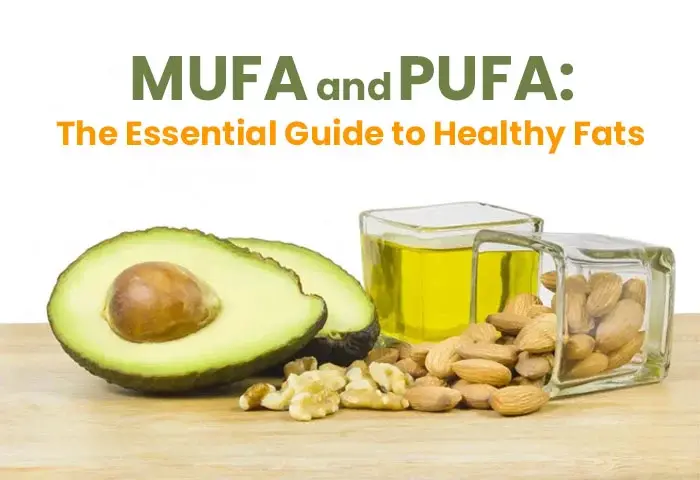Certain terms stand out as nutritional superstars in the ever-evolving landscape of nutrition and dietary trends. Two such terms are “MUFA” and “PUFA.” You’ve probably heard them thrown around in discussions about healthy eating, but what exactly do these acronyms stand for, and what’s the fuss?
In this blog post, we embark on an enlightening journey to uncover the secrets behind MUFA and PUFA, which are, in fact, not mere acronyms but the keys to unlocking a healthier, more balanced diet.
What is MUFA?
MUFA full form: Monounsaturated Fatty Acids
It is an unsaturated fat found in various plant-based and animal-based foods. These fats are classified as monounsaturated because they contain a single, double bond within their carbon chain, which gives them a unique structure and certain health benefits.
Examples of Monounsaturated Fatty Acids
- Olive Oil: Extra virgin olive oil is a well-known source of MUFAs and is commonly used for cooking and as a salad dressing.
- Avocados: Avocados are a great source of MUFAs, particularly oleic acid. They are a versatile and creamy addition to many dishes.
- Nuts: Various nuts, such as almonds, cashews, and peanuts, contain MUFAs. They make for a healthy and satisfying snack.
- Seeds: Sesame seeds and pumpkin seeds are examples of seeds that are high in MUFAs.
- Peanut Butter: Natural peanut butter, made from peanuts without added hydrogenated fats, is rich in MUFAs.
- Sunflower Oil: Sunflower oil is another cooking oil that contains MUFAs, although it’s lower in MUFAs than olive oil.
- Canola Oil: It is low in saturated fat and contains moderate MUFAs, making it a heart-healthy cooking oil.
- Dark Chocolate: Dark chocolate with a high cocoa content contains MUFAs, but it should be consumed in moderation due to its calorie content.
- Olives: Olives themselves are rich in MUFAs, and they are used in various dishes, snacks, and olive oil production.
Benefits of Monounsaturated Fats
- Heart Health: One of the most prominent advantages of MUFAs is their ability to promote heart health. They have been associated with a reduced risk of heart disease by improving blood lipid profiles. MUFAs can help lower bad cholesterol levels (LDL) while maintaining or increasing good cholesterol levels (HDL).
- Weight Management: Including MUFAs in your diet can benefit weight management. They have been shown to help with satiety, which can reduce overall calorie intake. This can make it easier to maintain a healthy weight and prevent overeating.
- Diabetes Control: MUFAs may play a role in managing blood sugar levels and improving insulin sensitivity, making them a valuable addition to diets for individuals with diabetes or those at risk of developing the condition.
- Antioxidant Support: Some foods rich in MUFAs, like olive oil, also contain antioxidants that further protect cells from oxidative damage and support overall health.
If you are searching for a healthy cooking oil, rice bran oil will be your best choice. Rice bran oil includes 38% monounsaturated, 37% polyunsaturated, and 25% saturated fatty acids. It has numerous health benefits and is good for your heart.
What is PUFA?
PUFA full form: Polyunsaturated Fatty Acids
Polyunsaturated Fatty Acids (PUFAs) are unsaturated fats characterized by multiple double bonds within their carbon chain structure. These multiple double bonds give PUFAs distinct properties and significantly impact their role in nutrition and health.
There are two primary types of PUFAs, each with its unique characteristics and health benefits:
- Omega-3 Fatty Acids: Omega-3s are well-known for their heart-healthy properties. They include eicosapentaenoic acid (EPA), docosahexaenoic acid (DHA), and alpha-linolenic acid (ALA). These essential fatty acids are critical in brain health, reducing inflammation and supporting cardiovascular health.
- Omega-6 Fatty Acids: Omega-6s, such as linoleic acid, are essential for various bodily functions, including skin health, cell membrane structure, and the production of important signalling molecules. However, an imbalance between omega-3 and omega-6 intake can contribute to inflammation and chronic health issues.
Examples of PUFA
Omega-3 Fatty Acids:
- Alpha-linolenic acid (ALA): Found in flaxseeds, chia seeds, and walnuts, ALA is a plant-based omega-3 fatty acid that the body can convert into eicosapentaenoic acid (EPA) and docosahexaenoic acid (DHA).
- Eicosapentaenoic acid (EPA): Commonly found in fatty fish like salmon, mackerel, and sardines, EPA is known for its anti-inflammatory properties and cardiovascular benefits.
- Docosahexaenoic acid (DHA): DHA is also abundant in fatty fish and is essential for brain health, especially during pregnancy and early childhood.
Omega-6 Fatty Acids:
- Linoleic acid: Found in vegetable oils like soybean oil, sunflower oil, and corn oil, linoleic acid is a fundamental omega-6 fatty acid in the Western diet.
- Arachidonic acid: Present in animal-based sources such as meat, poultry, and eggs, arachidonic acid is involved in inflammatory responses and various physiological processes.
Health Benefits of PUFAs
- Brain Function: DHA, an omega-3 fatty acid, is a key structural component of brain tissue and is crucial for cognitive function, memory, and overall brain health.
- Anti-Inflammatory Properties: Both omega-3 and omega-6 PUFAs play a role in regulating inflammation in the body. A balanced intake can help manage chronic inflammation, a risk factor for various health conditions.
- Skin Health: Omega-6 PUFAs, especially linoleic acid, support skin health by maintaining the integrity of the skin’s natural barrier and preventing moisture loss.
- Hormone Production: PUFAs are essential for producing important hormone-like compounds that regulate various physiological processes in the body.
What Similarities do MUFA and PUFA Share?
- MUFA and PUFA are unsaturated fatty acids.
- Both are considered healthier than saturated fats.
- They are essential components of our diet.
- Each gram of MUFA and PUFA provides 9 calories.
- Both types of fats can help lower LDL cholesterol levels.
- They remain in a liquid state at room temperature.
- MUFA and PUFA contribute to reducing the risk of cardiovascular diseases.
What is the Difference Between MUFA and PUFA?
Chemical Structure:
- MUFA: MUFAs have one double bond in their carbon chain.
- PUFA: PUFAs have multiple double bonds in their carbon chain.
Types:
- MUFA: Monounsaturated fats include fats like oleic acid and are typically found in olive oil, avocados, and nuts.
- PUFA: Polyunsaturated fats include omega-3 and omega-6 fatty acids found in fatty fish, flaxseeds, and various vegetable oils.
Health Benefits:
- MUFA: MUFAs are known for improving heart health, managing weight, and reducing inflammation. They are particularly associated with reducing LDL (bad) cholesterol.
- PUFA: PUFAs, especially omega-3 fatty acids, are vital for brain function, reducing inflammation, and supporting cardiovascular health. Omega-6 fatty acids are essential for skin health and hormone production.
Food Sources:
- MUFA: Olive oil, avocados, and nuts are rich sources of MUFAs.
- PUFA: Fatty fish (salmon, mackerel, etc.), flaxseeds, and vegetable oils (e.g., soybean, corn, and sunflower oil) are high in PUFAs.
Ratio and Balance:
- Maintaining a balanced intake of omega-3 and omega-6 PUFAs is crucial for health. An imbalance, typically with excess omega-6s, can contribute to inflammation and various health issues.
Dietary Implications:
- MUFA: MUFAs are commonly found in Mediterranean diets and are often used for cooking or salad dressing.
- PUFA: PUFAs are integral to various dietary patterns, and omega-3 supplements are also popular for those seeking to boost their intake.
Parting Thoughts
In exploring Monounsaturated Fatty Acids (MUFAs) and Polyunsaturated Fatty Acids (PUFAs), we’ve unveiled the fascinating world of these unsaturated fats and their critical roles in nutrition and health. Both MUFAs and PUFAs, while belonging to the same unsaturated fat family, bring their unique qualities to the table.
The key takeaway is that MUFAs and PUFAs are valuable in a balanced diet. These healthy fats can replace less beneficial saturated fats and should be celebrated to promote overall well-being. Incorporating various food sources rich in MUFAs and PUFAs adds a delectable dimension to your meals and supports your journey towards a healthier, more heart-conscious, and well-nourished life.
Buy SVR Oil’s Rice bran oil, which will help you use advanced technologies and processes that preserve the natural goodness of the rice bran and make it an ideal option for your health.
Contact SVR Oil today to learn more about their products.

